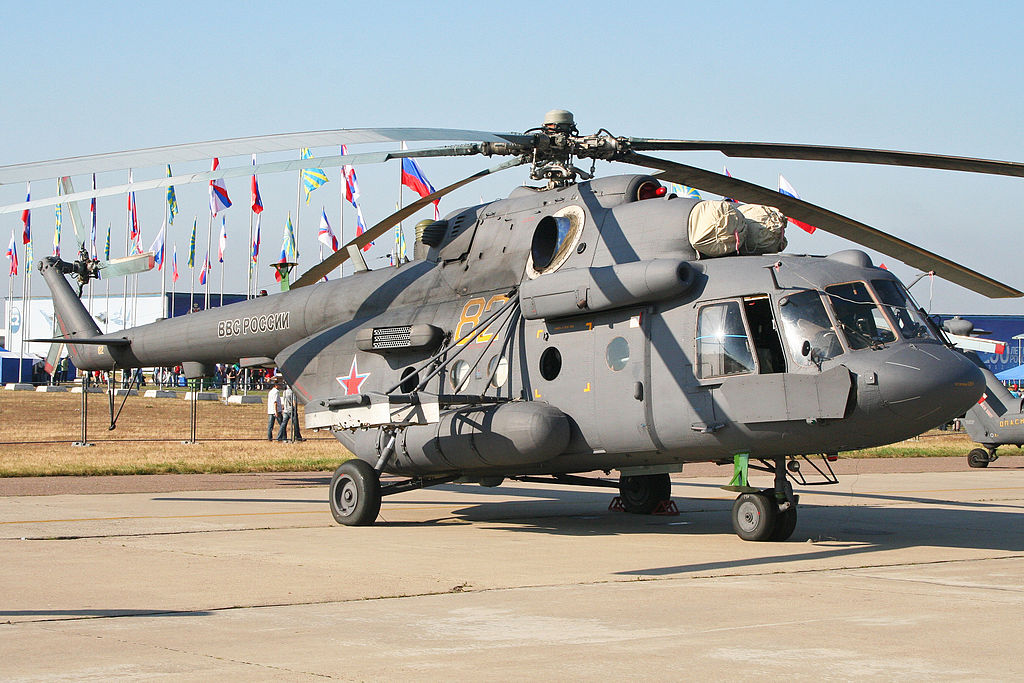
A Russian military Mi helicopter of the kind Ecuador was prepared to donate to Ukraine.
“The decision unleashed the fury of the Kremlin, which defended the parts sold to Ecuador years ago.”
Since the start of the Russia-Ukraine war, Latin American and Caribbean countries have been reticent to get involved.[i] Specifically, they have resisted calls to send Russian military equipment stockpiles to support either side of the conflict. For this reason, Ecuador stood out when, following the recent declaration of an “internal armed conflict,” Spanish wire agency EFE reports that President Noboa expressed his country’s desire to trade Soviet-era military equipment for a $200 million security package of new equipment from the United States. This security package is meant to bolster the government’s position in the current domestic security crisis.[ii] The Soviet-era equipment, six Mi-8 [RG1] helicopters, a rocket launcher, and anti-aircraft systems, from previous arms deals with Russia would then be transferred to Ukraine. To avoid provoking the ire of Russia by signaling overt support for Ukraine’s cause, EFE reports that the Noboa government has referred to this equipment, as inoperative “junk.” Nevertheless, Russia responded angrily and referred to original contracts for the equipment, which allegedly prohibit the export of this equipment to third parties. In addition, following Noboa’s announcement, according to the second excerpted article from the Argentine regional outlet Infobae, Russia’s phytosanitary agency halted imports of Ecuadorian bananas, claiming an uptick in flies. The article also notes that Russia is Ecuador’s second-largest customer for banana exports, and a halt in Russia’s imports of Ecuadorian bananas will hurt Ecuador economically and force it to quickly divert exports to other countries. While the quantity and types of weapons Ecuador plans to send to the United States (and eventually on to Ukraine) will not, by themselves, change Ukraine’s fortunes on the battlefield, the decision is a potential watershed moment for Latin America because its governments have generally pursued a studious policy of “non-alignment,” with several regional leaders declining to send Soviet-era equipment in their stockpiles.[iii] It is possible that Ecuador may pave the way for the region to assist Ukraine despite the threat of economic reprisals.
Sources:
“EE.UU. confirma que equipos soviéticos de Ecuador irán a Ucrania para guerra contra Rusia (The US confirms that Soviet equipment from Ecuador will go to Ukraine for war against Russia),” EFE (Spanish wire agency), 8 February 2024. https://es-us.finanzas.yahoo.com/noticias/ee-uu-confirma-equipos-sovi%C3%A9ticos-215123186.html
The president of Ecuador, Daniel Noboa, described the equipment as ‘scrap’ so his country will receive new equipment worth about 200 million dollars…the Russian government transmitted to the Ecuadorian government its position regarding these supplies, ‘indicating the specific points of the agreements and contracts’ linked to Russian military supplies to Ecuador that the South American nation would violate if it re-exported them.
“Ecuador se ve obligado a buscar nuevos mercados para sus bananas tras el cese de exportaciones a Rusia (Ecuador is forced to look for new markets for its bananas after the cessation of exports to Russia),” Infobae (Argentine regional outlet), 14 February 2024. https://www.infobae.com/america/america-latina/2024/02/14/ecuador-se-ve-obligado-a-buscar-nuevos-mercados-para-sus-bananas-tras-el-cese-de-exportaciones-a-rusia/
The decision unleashed the fury of the Kremlin, which defended the parts sold to Ecuador years ago…The measure ordered by Vladimir Putin will considerably affect Ecuadorian exporters and, consequently, the profits that the Ecuadorian government receives from bananas. Now, Noboa must campaign to relocate one of its top products in the world, outside of nations that interpose their political interests on commercial ones. At the same time, the president continues with his war against gangs, launched in early January, which he hopes to promote with new equipment.
Notes:
[i] For greater detail on how the region has remained “non-aligned,” see: Ryan C. Berg, Christopher Hernandez-Roy, Juliana Rubio, Henry Ziemer, and Rubi Bledsoe, “A Hesitant Hemisphere: How Latin America has been Shaped by the War in Ukraine,” Center for Strategic & International Studies, 27 February 2023. https://www.csis.org/analysis/hesitant-hemisphere-how-latin-america-has-been-shaped-war-ukraine
[ii] For more, see: Ryan Berg “Rising Violence Prompts Ecuador To Declare ‘Internal Armed Conflict’,” OE Watch, 02-2024. Need Link
[iii] For more on Latin America’s response to the war in Ukraine, read: Ryan C. Berg, Christopher Hernandez-Roy, Juliana Rubio, Henry Ziemer, and Rubi Bledsoe, “Two Years Later: LAC and Russia’s War in Ukraine,” Center for Strategic & International Studies, February 22, 2024, https://www.csis.org/analysis/two-years-later-lac-and-russias-war-ukraine.
Image Information:
Image: A Russian military Mi helicopter of the kind Ecuador was prepared to donate to Ukraine.
Source: https://commons.wikimedia.org/wiki/File:Mil_Mi-8MTV-5_Hip_82_yellow_%288587491042%29.jpg
Attribution: CC BY-SA 2.0 DEED
